 |
April 2018
|
April 2018 // Volume 56 // Number 2 // Research In Brief // v56-2rb2
Assessing Washington State Landowners' Interest and Concerns Regarding Growing Bioenergy Crops
Abstract
Bioenergy industries will depend, in part, on interested and informed landowners who are willing to grow bioenergy crops. We surveyed landowners in Washington State to gain insight into their knowledge and interest regarding bioenergy crops and the importance of various cropping decision factors. The majority of landowners surveyed were not familiar with bioenergy crops and/or were unlikely to grow them. They indicated that profit, soil and land preservation, and water quality are all important factors to consider when making cropping decisions. Our results provide Extension professionals with an enhanced understanding of perceived challenges and advantages related to growing bioenergy crops.
Introduction
Impacts from burning fossil fuels have spurred research into alternative fuel industries around the world. Biofuels, which are liquid or gas transportation fuels produced from biomass, are among the replacements for petroleum-based fuels (Nigam & Singh, 2011). For a bioenergy economy (hereafter bioeconomy) to be successful, understanding interests and perceptions of landowners, who are vital to the production of food, fiber, and fuel, is critical. Human factors of bioenergy systems, such as social acceptance, are understudied, despite a large information deficit and significant public concern.
Advanced Hardwood Biofuels Northwest (AHB) is a consortium providing the building blocks for a poplar-based fuel industry in the Pacific Northwest. Poplar trees are a short-rotation woody crop that can be converted into liquid biofuel that is compatible with current engines and infrastructure. AHB has made great strides in improving growing, harvesting, and conversion techniques for poplar biofuels. Concurrently, AHB has studied how best to incorporate various stakeholders, including landowners, into the bioeconomy. One of the goals of a bioeconomy is rural revitalization through increased crop diversification and farming options (Vilsack, 2016).
Research on the social sustainability of bioeconomies is limited, although landowner willingness surveys have been conducted in multiple regions. Most commonly, researchers have found that landowners do not know much about the technical details or the general process of growing bioenergy crops (Grebner, Perez-Verdin, Henderson, & Londo, 2009; Joshi, Grebner, Henderson, & Gruchy, 2015; Shaw, Hazel, Bardon, & Jayaratne, 2012; Wen, Ignosh, Parrish, Stowe, & Jones, 2009). Additionally, understanding bioenergy does not necessarily translate to awareness of particular crops, such as poplars, and how to grow them (Fratanduono, Steelman, Peterson, McHale, & Fratanduono, 2013).
Landowners, even those who are supportive of bioenergy crops, have brought up several concerns (Wen et al., 2009). Profiting from bioenergy crops is often seen as a major challenge, especially when these crops are perceived to be in conflict with more traditional land use, such as timber harvesting and production of food and feed crops (Joshi & Mehmood, 2011; Kelsey & Franke, 2009; Tomei & Helliwell, 2016). Landowners have expressed concerns about soil and wildlife impacts, agronomics of growing bioenergy crops, lack of infrastructure surrounding bioenergy production, environmental impacts of biorefineries, and lack of policies incentivizing bioenergy crop production (Kelsey & Franke, 2009; Selfa, Kulcsar, Bain, Goe, & Middendorf, 2010; Villamil, Alexander, Silvis, & Gray, 2012). Social and cultural norms also can influence willingness to grow bioenergy crops. For instance, when bioenergy crop production is linked to reduced dependence on foreign oil, adoption is supported by the cultural value of energy independence (Kelsey & Franke, 2009; Skevas, Swinton, & Hayden, 2014). Landowners across the world base their decisions on a variety of factors, many of which are not economic (Augustenborg et al., 2012; Becker, Eryilmaz, Klapperich, & Kilgore, 2013; Raymond, Brown, & Robinson, 2011; Stjepan et al., 2015).
We used a survey to explore crop-growing patterns of landowners in Washington State and the landowners' interest in growing bioenergy crops, especially poplar trees. Questions about how landowners make cropping decisions and what factors influence decisions to plant a bioenergy crop were included. Extension-facilitated education has increased landowners' willingness to harvest woody biomass for bioenergy production (Shaw et al., 2012). Knowing more about motivations influencing cropping decisions allows Extension professionals to provide better information to support landowners making bioenergy crop decisions.
Methods
Sample Selection
We collected contact information for landowners through a statewide geographic information system landowner database (Rogers, Cooke, & Comnick, 2012). Researchers at the University of Washington created a land parcel database for Washington State and then conducted a suitability study to determine the areas appropriate for poplar growth, with and without irrigation (Rogers et al., 2012). For our sample, we selected land parcels that were highly or moderately suitable for growing poplar without irrigation. We focused on two categories of lands: (a) land for resource production and extraction and (b) undeveloped land. To ensure that we sampled landowners who could effectively grow poplar for biomass, we included only land parcels larger than 20 ac. We also chose not to include federal, state, agency, trust, or organization–owned land or developed land.
This process yielded 40,000 parcels of which we randomly selected 1,050 parcels and obtained landowner contact information. We used stratified random sampling to ensure that landowners with small (20–40 ac), medium (41–160 ac), and large (>160 ac) parcels of land would be represented. After removing incorrect contacts, surveys were sent to 900 landowners.
Data Collection
We developed a 38-question survey to assess landowner interests in and concerns about adopting bioenergy crops. To ensure validity, the survey was created collaboratively with Washington State University (WSU) Extension, WSU's Social and Economic Sciences Research Center, and faculty at WSU and the University of Washington who had been conducting qualitative research with landowners. Survey questions addressed current land use; interest in adopting new crops, including energy crops; demographic information; farm income; and long-term plans for the land. We asked respondents to indicate which cropping decision factor, from a list of six, was most important to them when making decisions. We also asked them to rate how important each factor was, irrespective of the others, with response options ranging from 1 (not important) to 4 (very important). The six cropping decision factors we included were profit, risk, tradition, soil preservation, water quality, and land conservation (maintaining the quality of the landscape). Most questions included opportunities to add qualitative comments.
We conducted the survey in two phases, one from March 2014 through June 2014 and the other from November 2014 through January 2015, following the tailored design method (Dillman, Smyth, & Christian, 2009). We sent a letter with a link to an online version of the survey, followed by mailed reminders and paper replacement surveys. We received 156 completed surveys, for a 17% response rate.
Results and Discussion
Landowners' Current Cropping Decisions
Economic models of bioenergy industries often assume that if bioenergy crops are profitable, landowners will grow them (Parker et al., 2010). Our results support the assumption that profit is a key factor. Landowners generally selected profit when asked to choose the most important factor of those listed (Figure 1).
Figure 1.
Most Important Cropping Decision Factor for Washington Landowners
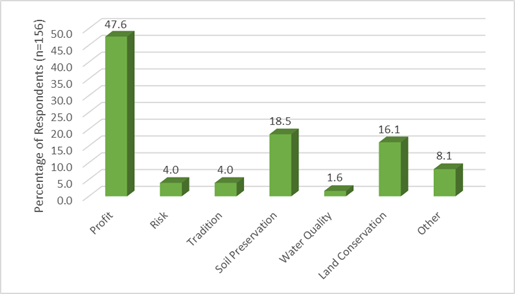
When landowners were asked to rate the importance of factors individually, the results were more complex (Figure 2). Soil preservation and land conservation were considered "very important" by 52% and 47% of respondents, respectively. In addition, few landowners rated soil preservation (1.5%), water quality (3.8%), and land conservation (2.3%) as unimportant, implying that cropping decision making is a multidimensional process. On the other hand, tradition was the least important factor to our respondents. Given the relative importance of soil preservation, land conservation, and water quality, landowners may be interested in receiving information about the environmental benefits resulting from the cultivation of certain bioenergy crops.
Figure 2.
Perceived Importance of Cropping Decision Factors
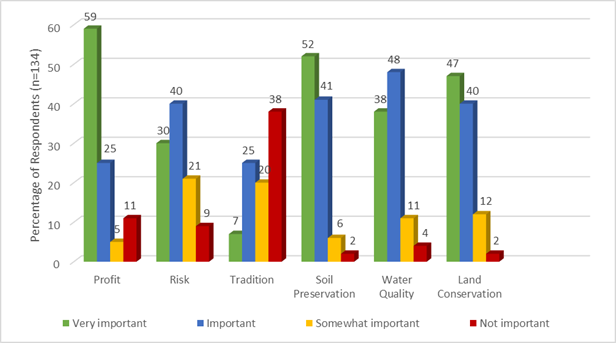
When determining which bioenergy crops would work best for a landowner, it is helpful to know what the landowner is already doing (Table 1) so that a bioenergy crop could be smoothly integrated into his or her operation. We found that a large majority of landowners in our sample grew annual crops and/or hay as their primary and secondary crops, whereas few grew perennial crops such as fruit trees. Depending on the reasons for growing annual rather than perennial crops, there may be a lack of technical knowledge or higher upfront equipment cost for woody biomass crops than for annual bioenergy crops such as oilseeds. Some respondents mentioned in the comments that hay was critical for supporting a ranching operation, a factor that could make converting fields to a bioenergy crop more difficult. Cropping decision and poplar adoption tools for interested landowners are in development (Bandaru et al., 2015).
| Crop grown | As a primary crop | As a secondary crop |
| Annual crop | 57% | 64% |
| Hay or pasture | 28% | 39% |
| Perennial | 5% | 15% |
| Other | 10% | 16% |
Landowners interested in or planning to grow new crops are more likely to adopt bioenergy crops (Villamil et al., 2012). We asked landowners about when they last tried a new crop of any type (Figure 3). Survey responses showed that more than half of the landowners (58%) had tried new crops in recent years. Unfortunately, many respondents did not answer this question, limiting the usefulness of this information.
Figure 3.
Respondents' Most Recent Year of Trying a New Crop
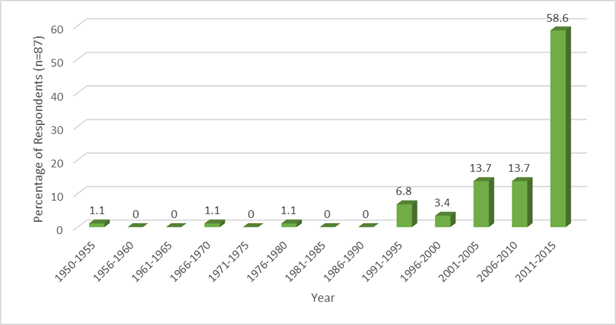
Decisions Regarding Bioenergy Crops
Research in other states has uncovered a lack of knowledge or experience concerning bioenergy crops (e.g., Skevas et al., 2014). Only 8.3% of our respondents had grown bioenergy crops in the preceding 3 years. Few landowners had grown or planned to grow these crops, and almost half of respondents were uninterested in doing so. Well over half of the respondents (65.7%) said they were not likely to grow a bioenergy crop in the subsequent 5 years, and 45.7% said they were not interested in growing a bioenergy crop (Figures 4 and 5).
Figure 4.
Likelihood of Growing a Bioenergy Crop in the Next Five Years
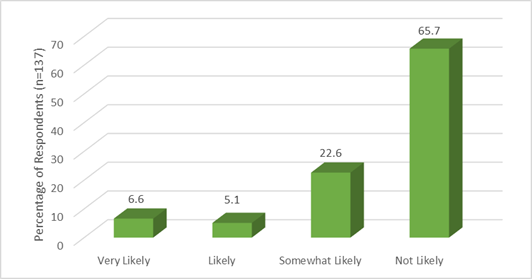
Figure 5.
Level of Interest in Growing Bioenergy Crops
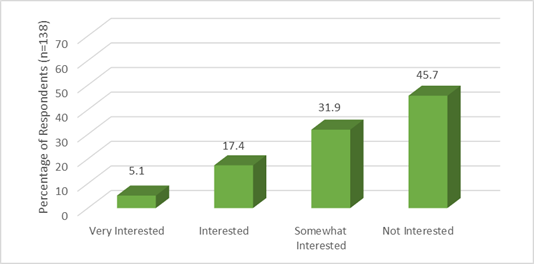
We wanted to determine what factors might be important to landowners when deciding whether to grow a bioenergy crop (Figure 6). As expected, opportunity to make money from growing the bioenergy crop was the factor most frequently cited as very important. However, other decision factors, such as soil improvement and ease with which the bioenergy crop can be grown, also were considered important.
Figure 6.
Cropping Decision Factors for Growing Bioenergy Crops
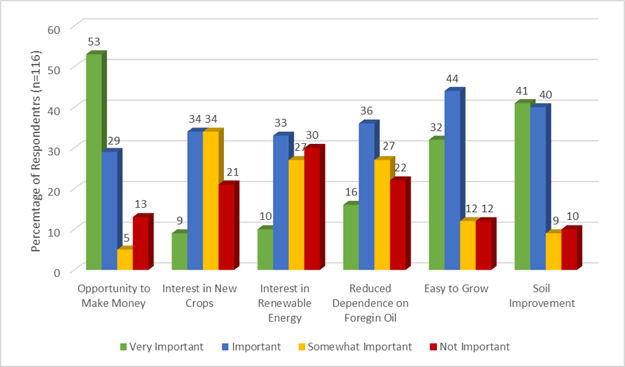
Qualitative Data
In the comment sections on the survey, respondents frequently expressed their lack of knowledge necessary for growing bioenergy crops. They asked questions about the amount of water needed, what to do after harvesting the crops, approaches for returning fields to other forms of agriculture, and potential animal damage. Additionally, some respondents mentioned that others who grew tree crops had been let down by the pulp/paper market. Respondents questioned whether poplar for bioenergy would be a similar "fad." Lack of local opportunities for selling bioenergy crops was cited as a reason not to grow them. Some respondents were participating in the Conservation Reserve Program and could not use lands for bioenergy crop production, a circumstance revealing that there may be some policy issues to explore to accommodate energy crops.
Conclusions and Recommendations
Our survey results highlight the need to provide more information to landowners. We also can make inferences about the relative importance of various factors influencing cropping decisions and the priorities and interests of Washington State landowners. Extension professionals in other states have found Extension-led educational programs helpful for increasing knowledge and interest in biomass feedstock production (Shaw et al., 2012). It could be illuminating to see how landowners respond to information and workshops on how to grow and harvest bioenergy crops in Washington State.
Creating a vibrant and sustainable bioeconomy in Washington State will require landowners who are knowledgeable about growing bioenergy crops and interested in investing in the bioenergy market. Profit-making opportunities, followed by water and soil quality considerations, drive many of the crop decisions of our respondents.
There are limitations to the conclusions we can draw from our survey. We focused on one state and surveyed only landowners with land suitable for poplar. There was a relatively low response rate, yielding a confidence level of 90% and 5% margin of error. Additionally, we may have missed some cropping decision factors that are important to landowners. Despite the limitations, the survey findings still may help Extension professionals in their community energy-related programming, especially with regard to making sure they are providing information that speaks to their constituents' priorities. Future research should involve looking more deeply into the reasons behind these findings, particularly the salience of certain cropping decision factors over others.
Although Extension has the tools to inform landowners about growing bioenergy crops, uncertainty regarding the economic future of biofuels, particularly cellulosic biofuels, cannot be ignored. This is a significant consideration, especially given the profit-oriented focus of most landowners. Consequently, Extension may be more useful to landowners by informing them about how some bioenergy crops fulfill other objectives, such as those associated with soil preservation, land conservation, and water quality.
Acknowledgments
First, we would like to thank the landowners who took our survey. We also would like to thank Noelle Hart, Nora Haider, and Kevin Zobrist for their aid with the survey and the manuscript; Stanley Asah for his help in designing the survey; and Rose Krebill-Prather for implementing the survey and overseeing preliminary data analysis. This research was supported by Agriculture and Food Research Initiative Competitive Grant no. 2011-68005-30407 from the U.S. Department of Agriculture National Institute of Food and Agriculture.
References
Augustenborg, C. A., Finnan, J., McBennett, L., Connolly, V., Priegnitz, U., & Müller, C. (2012). Farmers' perspectives for the development of a bioenergy industry in Ireland. Global Change Biology Bioenergy, 4(5), 597–610. https://doi.org/10.1111/j.1757-1707.2011.01151.x
Bandaru, V., Parker, N., Hart, Q., Jenner, M., Yeo, B., Crawford, J. T., . . . Jenkins, B. (2015). Economic sustainability modeling provides decision support for assessing hybrid poplar-based biofuel development in California. California Agriculture, 69(3), 171–176. https://doi.org/10.3733/ca.v069n03p171
Becker, D. R., Eryilmaz, D., Klapperich, J. J., & Kilgore, M. A. (2013). Social availability of residual woody biomass from nonindustrial private woodland owners in Minnesota and Wisconsin. Biomass and Bioenergy, 56, 82–91. http://dx.doi.org/10.1016/j.biombioe.2013.04.031
Dillman, D., Smyth, J. D., & Christian, L. M. (2009). Internet, mail, and mixed-mode surveys: The tailored design method. Hoboken, NJ: John Wiley & Sons.
Fratanduono, M. L., Steelman, T. A., Peterson, M., McHale, M., & Fratanduono, D. E. (2013). Barriers to utilization of municipal biomass residues for bioenergy. Journal of Extension, 51(2), Article 2FEA10. Available at: https://joe.org/joe/2013april/a10.php
Grebner, D. L., Perez-Verdin, G., Henderson, J. E., & Londo, A. J. (2009). Bioenergy from woody biomass, potential for economic development, and the need for Extension. Journal of Extension, 47(6), Article 6FEA7. Available at: https://www.joe.org/joe/2009december/a7.php
Joshi, O., Grebner, D. L., Henderson, J. E., & Gruchy, S. R. (2015). Landowners, bioenergy, and Extension strategies. Journal of Extension, 53(2), Article 2FEA3. Available at: https://www.joe.org/joe/2015april/a3.php
Joshi, O., & Mehmood, S. R. (2011). Factors affecting nonindustrial private forest landowners' willingness to supply woody biomass. Biomass and Bioenergy, 35(1), 186–192. https://doi.org/10.1016/j.biombioe.2010.08.016
Kelsey, K. D., & Franke, T. C. (2009). The producers' stake in the bioeconomy: A survey of Oklahoma producers' knowledge and willingness to grow dedicated biofuel crops. Journal of Extension, 47(1), Article 1RIB5. Available at: https://www.joe.org/joe/2009february/rb5.php
Nigam, P. S., & Singh, A. (2011). Production of liquid biofuels from renewable resources. Progress in Energy and Combustion Science, 37(1), 52–68. doi:10.1016/j.pecs.2010.01.003
Parker, N., Tittmann, P., Hart, Q., Nelson, R., Skog, K., Schmidt, A., . . . Jenkins, B. (2010). Development of a biorefinery optimized biofuel supply curve for the western United States. Biomass and Bioenergy, 34(11), 1597–1607. doi:10.1016/j.biombioe.2010.06.007
Raymond, C., Brown, G., & Robinson, G. (2011). The influence of place attachment, and moral and normative concerns on the conservation of native vegetation: A test of two behavioral models. Journal of Environmental Psychology, 31, 323–335. doi:10.1016/j.jenvp.2011.08.006
Rogers, L. W., Cooke, A., & Comnick, J. (2012). The Washington State forest biomass supply assessment database [Digital data, March, 2012]. Seattle, WA: University of Washington.
Selfa, T., Kulcsar, L., Bain, C., Goe, R., & Middendorf, G. (2010). Biofuels bonanza? Exploring community perceptions of the promise and perils of biofuel production. Biomass and Bioenergy, 35(4), 1379–1389. https://doi.org/10.1016/j.biombioe.2010.09.008
Shaw, J., Hazel, D., Bardon, R., & Jayaratne, K.S.U. (2012). Landowners' knowledge, attitudes, and aspirations towards woody biomass markets in North Carolina. Journal of Extension, 50(4), Article 4FEA9. Available at: https://joe.org/joe/2012august/a9.php
Skevas, T., Swinton, S. M., & Hayden, N. J. (2014). What type of landowner would supply marginal land for energy crops? Biomass and Bioenergy, 67, 252–259. https://doi.org/10.1016/j.biombioe.2014.05.011
Stjepan, P., Mersudin, A., Dzenan, B., Nenad, P., Makedonka, S., Dane, M., & Špela, P. M. (2015). Private forest owners' willingness to supply woody biomass in selected south-eastern European countries. Biomass and Bioenergy, 81, 144–153. https://doi.org/10.1016/j.biombioe.2015.06.011
Tomei, J., & Helliwell, R. (2016). Food versus fuel? Going beyond biofuels. Land Use Policy, 56, 320–326. https://doi.org/10.1016/j.landusepol.2015.11.015
Villamil, M., Alexander, M., Silvis, A. H., & Gray, M. E. (2012). Producer perceptions and information needs regarding their adoption of bioenergy crops. Renewable and Sustainable Energy Reviews, 16(6), 3604–3612. https://doi.org/10.1016/j.rser.2012.03.033
Vilsack, T. (2016, October 3). Powering America with a more sustainable energy future. Retrieved from https://medium.com/usda-results
Wen, Z., Ignosh, J., Parrish, D., Stowe, J., & Jones, B. (2009). Identifying farmers' interest in growing switchgrass for bioenergy in southern Virginia. Journal of Extension, 47(5), Article 5RIB7. Available at: https://www.joe.org/joe/2009october/rb7.php




